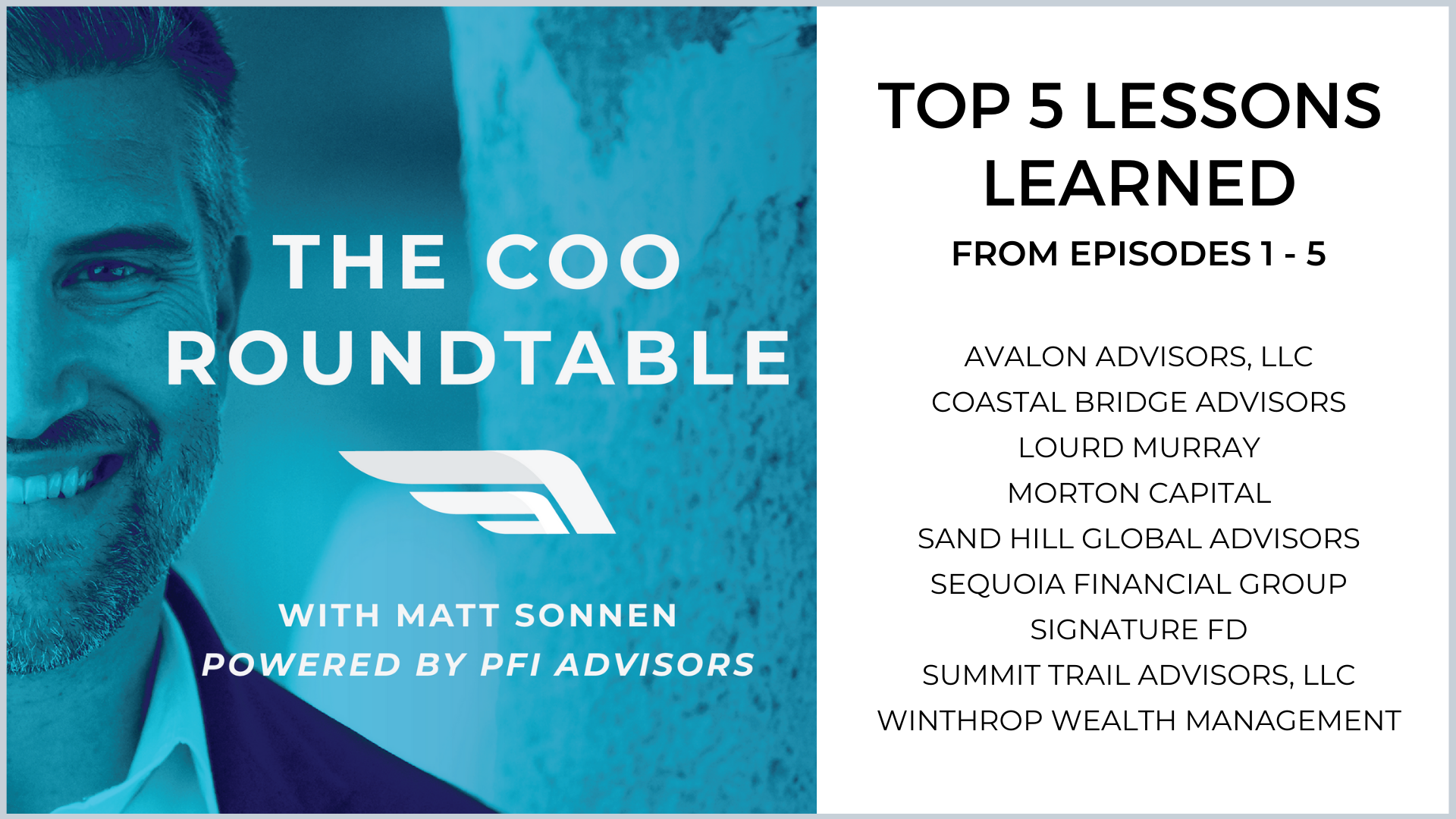We’d like thank everyone who has listened, subscribed, and given feedback on The COO Roundtable thus far. We’ve really enjoyed conducting these interviews and hearing all your reactions. Our interviews to date have included ten operations professionals at nine multibillion-dollar RIAs across the country accounting for over $30 billion in client assets under management. With five episodes under our belt, we felt it was the perfect time to recap the top five lessons we’ve learned from our featured guests.
EP 1 featuring Jeff Fuhrman & Tony Craun: How to Effectively Hire and Retain Talent
In Episode 1, Jeff and Tony discussed their unique approaches toward hiring and retaining top tier talent. In an effort to attract young talent, Tony focuses on selling the wide variety of hands-on opportunities RIAs (specifically, Sand Hill Global Advisors) can provide to young professionals. While RIAs may lose to the big-name brands on “…name recognition and compensation,” says Tony, they “…win on opportunity for defined careers paths and growth,” offering a smaller firm and more entrepreneurial environment. In terms of retaining this talent, Jeff has made it a focus at Coastal Bridge Advisors to create hyper-specific job descriptions. These job descriptions are then reviewed by the employee and their manager every 90 days. Jeff notes this helps Coastal Bridge with “…training and development, career pathing and even resource allocation,” and prevents “…confusion, inefficiencies, and frustration.”
EP 2 featuring Gary Bonner & Mike Lee: How Firms can Balance Profit and Growth
In Episode 2, Gary and Mike tackled the age-old debate: profit vs. growth. Gary highlights that it’s a balance to focus on “…growth, but in a profitable way,” adding that, “Going out and just adding assets where there’s no reasonable expectation of revenue is not the way to grow.” Gary believes that, “…it would be better to grow from the investor perspective, that the next dollar actually is generating a profit versus just showing up on an AUM report when there was no revenue associated with it.” Mike concurs, saying, “We have to focus on both.” As a COO, Mike believes he contributes to growth in an “indirect capacity” explaining his contribution is “…in the form of enablement and the servicing infrastructure that we oversee to support the growth.”
EP 3 featuring Trevor Chuna & Shaun Kapusinski: How to Drive Technology Improvements with the Client Experience in Mind
In Episode 3, Trevor and Shaun provided deep detail in how Sequoia Financial Group drives their client experience through technology. While internal-facing technology improvements may appear to have little affect on the end client, Trevor and Shaun believe the opposite. Trevor views their white glove service as an opportunity to “…empower the client to work with us the way that they want to work us, not an opportunity to do everything for the client.” Sequoia leverages Salesforce to develop their internal process to deliver that client service. Shaun highlights that Sequoia went for the best in breed experience, not product, when it came to constructing their tech stack. He states that their goal in doing this was to get “…advisors to that [client] information faster, allowing them to service their clients better.”
EP 4 featuring Tom Harms & Stacey McKinnon: How the COO Role Fits in the Broader Structure of the Organization
In Episode 4, Tom and Stacey spoke to how they see the role of COO fitting in to the greater landscape of a firm. At Summit Trail, Tom sees his role as a “…myriad responsibilities and challenges and questions,” but in answering these questions, he’s empowering the individuals at the firm to “…get the job done and get the job right that really matters.” On top of this, Tom believes his mission “…is to build and help ensure that Summit Trail Advisors is built on a sound foundation and has individuals in place to last the next 10-20 years.” Stacey sees “…the CEO as the visionary and the COO as the integrator.” With this in mind, she likens her role as COO to the director of a play. In her play analogy, the CEO and the advisors are the actors, and she and her operations staff are the sound, lighting, and makeup teams. Stacey’s job is “…really making sure that we have cohesion between all the different teams.”
EP 5 featuring Heather Fortner & Lucas Winthrop: How to Effectively Manage Both Personal and Firmwide Time as a COO
In Episode 5, Heather and Lucas discussed the steps they take to put time back in the hands of their advisors and employees. Heather likes to look at it as energy management rather than time management. “I do really try to manage my energies more than I manage my time and be cognizant of the things that I am allowing to use my energy.” She does this in an effort to “…filter out what is noise, take what is important, and constantly communicate those things to the team.” Lucas views time as “…the most precious commodity,” stating, “I beta test everything we do with a select group of clients whom I manage and work with.” These select clients act as Lucas’ “sounding board” and enable Winthrop Wealth to hone in on their client- facing technology and effectively put more time back in the hands of their advisors.

